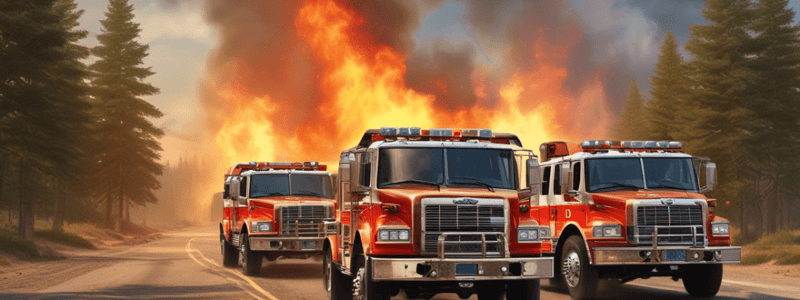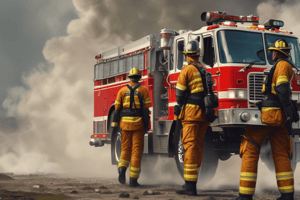Podcast
Questions and Answers
Who can enter adjacent lands without a warrant in case of a fire or emergency?
Who can enter adjacent lands without a warrant in case of a fire or emergency?
- Only the Fire Marshal
- A firefighter or a person authorized by the fire chief, the Fire Marshal or an assistant to the Fire Marshal (correct)
- Only a firefighter
- Any member of the public
What is the purpose of entering adjacent lands in case of a serious threat to health and safety?
What is the purpose of entering adjacent lands in case of a serious threat to health and safety?
- To fight the fire
- To remove or reduce the threat (correct)
- To investigate the cause of the fire
- To provide rescue or emergency services
Who can authorize a person to enter lands or premises to prevent the spread of a fire?
Who can authorize a person to enter lands or premises to prevent the spread of a fire?
- The Fire Marshal
- The fire chief (correct)
- Any firefighter
- The assistant to the Fire Marshal
What is the purpose of entering lands or premises where a fire is occurring, or adjacent to those lands or premises?
What is the purpose of entering lands or premises where a fire is occurring, or adjacent to those lands or premises?
What can be done to adjacent lands or premises to prevent the spread of a fire?
What can be done to adjacent lands or premises to prevent the spread of a fire?
Who has the opinion on whether it is necessary to pull down or remove buildings, structures or things to prevent the spread of a fire?
Who has the opinion on whether it is necessary to pull down or remove buildings, structures or things to prevent the spread of a fire?
Who may enter lands or premises outside the territorial limits of the municipality without a warrant?
Who may enter lands or premises outside the territorial limits of the municipality without a warrant?
What is the purpose of a firefighter's entry onto land or premises outside the municipality?
What is the purpose of a firefighter's entry onto land or premises outside the municipality?
What is required for a firefighter to enter lands or premises outside the municipality without a warrant?
What is required for a firefighter to enter lands or premises outside the municipality without a warrant?
What is automatic aid?
What is automatic aid?
What happens to a firefighter's right of entry at common law?
What happens to a firefighter's right of entry at common law?
Who may enter land or premises without a warrant if a fire has occurred or is likely to occur?
Who may enter land or premises without a warrant if a fire has occurred or is likely to occur?
What may the Fire Marshal or a fire chief do upon entering land or premises?
What may the Fire Marshal or a fire chief do upon entering land or premises?
Why may a person who enters land or premises under subsection (1) enter adjacent land or premises?
Why may a person who enters land or premises under subsection (1) enter adjacent land or premises?
What is not permitted when entering land or premises under subsection (1) or (3)?
What is not permitted when entering land or premises under subsection (1) or (3)?
When may a firefighter or fire chief enter lands or premises outside the territorial limits of the municipality?
When may a firefighter or fire chief enter lands or premises outside the territorial limits of the municipality?
Under what circumstances may a justice of the peace issue a warrant authorizing the Fire Marshal or a fire chief to enter land or premises?
Under what circumstances may a justice of the peace issue a warrant authorizing the Fire Marshal or a fire chief to enter land or premises?
What is specified in a warrant issued under subsection (6)?
What is specified in a warrant issued under subsection (6)?
What may a justice of the peace extend for a warrant issued under subsection (6)?
What may a justice of the peace extend for a warrant issued under subsection (6)?
Who may call on police officers as necessary and use force as necessary to make an entry under section 15?
Who may call on police officers as necessary and use force as necessary to make an entry under section 15?
When may the Fire Marshal, an assistant to the Fire Marshal, or a fire chief enter on any land or premises without a warrant?
When may the Fire Marshal, an assistant to the Fire Marshal, or a fire chief enter on any land or premises without a warrant?
What must a person who enters land or premises under section 15 do promptly after exercising any powers under this section?
What must a person who enters land or premises under section 15 do promptly after exercising any powers under this section?
What must be posted by the person who gives notice under subsection (2)?
What must be posted by the person who gives notice under subsection (2)?
What must the notice under subsection (4) describe?
What must the notice under subsection (4) describe?
Under what circumstances may a person who enters on land or premises under section 15 use force?
Under what circumstances may a person who enters on land or premises under section 15 use force?
What may a fire chief do under subsection (1)?
What may a fire chief do under subsection (1)?
Flashcards are hidden until you start studying
Study Notes
Rights of Entry in Emergencies and Fire Investigations
- Firefighters or authorized persons can enter adjacent lands or premises without a warrant to fight a fire or provide rescue or emergency services if a fire or emergency has occurred or is occurring.
- They can also enter adjacent lands or premises to prevent the spread of fire or to remove or reduce a serious threat to health and safety.
Entry onto Land Outside Municipality
- Firefighters or authorized persons can enter lands or premises outside the territorial limits of their municipality to fight a fire or provide rescue or emergency services if there is no fire department or emergency response capability in the area.
- They can also enter lands or premises outside their municipality if there is an automatic aid agreement or other agreement in place.
Investigations
- The Fire Marshal or a fire chief can enter lands or premises without a warrant if a fire has occurred or is likely to occur.
- They can close off the area, remove and examine any materials or substances, take samples or photographs, and make reasonable inquiries.
- They can also enter adjacent lands or premises if necessary for the investigation.
Powers upon Entry
- The Fire Marshal or a fire chief can exercise a range of powers upon entry, including closing off the area, removing materials or substances, taking samples or photographs, and making inquiries.
- They can also require equipment to be operated or used under specific conditions.
Warrant Authorizing Entry
- A justice of the peace can issue a warrant authorizing the Fire Marshal or a fire chief to enter lands or premises if there are reasonable grounds to believe that entry is necessary for an investigation.
- The warrant can authorize the use of force if necessary.
Immediate Threat to Life
- If there is an immediate threat to life due to a risk of fire, the Fire Marshal, an assistant, or a fire chief can enter lands or premises without a warrant to remove or reduce the threat.
- They can remove people, post a fire watch, remove combustible materials, and take other measures to reduce the threat.
Notice to Owner
- After exercising powers under this section, the person who entered the lands or premises must give notice to the owner if their whereabouts are known.
- The notice must describe the location, state the reason for the entry, and list the actions taken to remove or reduce the threat.
Studying That Suits You
Use AI to generate personalized quizzes and flashcards to suit your learning preferences.


